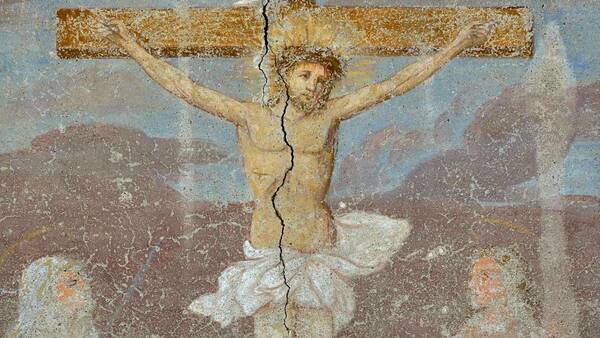A Memory and a Hope: The Feast of the Assumption, August 15, 2018. I went to the 5:30 pm Mass at our parish. It was just this day that the Pennsylvania Grand Jury investigation was made public. I felt overcome by a tide of sadness, a very deep sadness in which I could not seem to touch bottom. It was as though all the beautiful things in the world that I had cherished had been tarnished and blasted with corruption and swept away by chaos, scandal, and embarrassment. At the very same time I had the most vivid impression of the beauty of the Feast we were celebrating, here towards summer’s end, contemplating Mary as the Eschatological Icon of the Church. This is as intimate and hopeful and ennobling Truth as any there are. I felt an equal tide of gratitude welling up within me just as deep and maybe even deeper than the sadness I was feeling. This was instead a tide of gratitude for the Church who, for all these centuries, had faithfully safeguarded and proclaimed this beautiful truth in all its resplendent beauty such that so many seemingly remote centuries later, and so far from Israel, it reached me, its beneficiary. The sadness made me want to cry and so did the gratitude. I do not know which was stronger. Each made the other stronger. It is somewhere in the balance, or even the consubstantiality, of gratitude and sadness, that the place must be discovered from which we can find a response to the current crisis.
First: What is the theology of the Catholic Church? This has to be the starting place to guide any appropriate response. We do not often call this to mind, and many people do not understand it.
- “The Church . . . at once holy and always in need of purification, follows constantly the path of penance and renewal” (Lumen Gentium §8).
- Why is the Church “holy?” Because, the Catechism tells us, in a beautiful passage, “the Church is born primarily of Christ’s total self-giving for our salvation, anticipated in the institution of the Eucharist and fulfilled on the cross. ‘The origin and growth of the Church are symbolized by the blood and water which flowed from the open side of the crucified Jesus' (LG §3). 'For it was from the side of Christ as he slept the sleep of death upon the cross that there came forth the wondrous sacrament of the whole Church' (Sacrosanctum Concilium §5). As Eve was formed from the sleeping Adam’s side, so the Church was born from the pierced heart of Christ hanging dead on the cross” (CCC §766).
- What makes the Church and holds it in communion? It is this sacrificial love of Christ, not (in the first instance) her leaders, and certainly not (in any instance) the sum total of the virtue of the people making up the Church. That would hardly be a Church worth belonging to. We do not place our hope in the virtue or goodness of any of the sinful members of the Church, narrow and stinting as the virtue of the fallen always will be, compared to Christ’s. The constitution of the Church is rather the self-giving love of Christ, mediated to us by the sacraments, Baptism and Eucharist in particular, and not by any works of virtue of our own.
- The holiness of the Church is therefore the holiness of Christ’s sacrifical love that binds us in communion, and this love is immaculate, untainted with vested interest or touched with self-regard or status seeking. We place our hope in that love precisely because it is a love that bent down, unafraid to mix in with sinners and transform them away from solidarity in sin to solidarity in itself, in Himself.
- The Church is nevertheless always in need of purification because those bound in this self-emptying unafraid love, which had contempt for nothing human, are indeed human and sinners, some of us very corrupt sinners, including leaders. But sin cannot make void the cross of Christ or his love, and the Church of sinners is therefore nevertheless always the “sacrament” mediating Christ’s love to the world even before any virtue of its members. Our faith is that this love will perfect the whole, just as Mary as already been perfected, when it reaches the end of its pilgrimage.
This theology, our faith, gives us the ability, then, to look squarely at the evil that has been disclosed, on the one hand, and, on the other hand, not to be dismayed or separated from the mystery of the Church, because the mystery of the Church is the self-giving love of Christ which provides the bonds of communion that make the Church, and “nothing can separate us from the love of Christ” (cf. Rom. 8.31-39).
In other words, we can afford to look squarely at the evil because we know it cannot make void the Cross, the love which makes the Church, or the beauty of any truth she has handed down. Under this rubric comes the need for investigation of corruption in Church leadership by sober-minded panels duly authorized for this role by the bishops themselves. No evil will be healed unless it is surfaced and made visible. This is part of the purification of a Church always in need of purification, constantly “following the path of penance and renewal” (Lumen Gentium §8).
But looking squarely at evil has the risk of getting stuck there. The devil’s strategy is always to get us not just to look squarely at evil, but to stare, to keep looking, obsessively, until we feel dismayed, disillusioned and dispirited, so much so that we feel paralyzed, powerless, and everything seems pointless, and we slip into despair. Or we may get so angry that we end up destroying something we love, and not even care! Or else we will just develop a hardness of heart towards the Church that will drive out our gratitude for the gift of faith and beauty, and so just drift away to the secular culture.
So we must seek positive and constructive projects. What positive constructive projects can we propose? I propose a couple:
- A national conference to propose and explore what Pope Benedict called “CO-RESPONSIBILITY” for the mission of the Church.
- What is that? “Co-responsibility demands a change in mindset especially concerning the role of lay people in the Church. They should not be regarded as ‘collaborators’ of the clergy, but, rather, as people who are really ‘co-responsible’ for the Church’s being and acting. It is therefore important that a mature and committed laity be consolidated, which can make its own specific contribution to the ecclesial mission.” (Speech on the Occasion of the Sixth Ordinary Assembly of the International Forum of Catholic Action, August, 2012).
- This is a fruitful idea which has not been taken up or explored. It is a new way of thinking of lay leadership in the Church. What would the structures look like in which lay leadership can be “consolidated?” Governance of the Church pertains to Holy Orders, but perhaps not only to Holy Orders? Perhaps some of what now counts for governance could more properly be called “management”?
- Convene a strategic Task Force of key leaders in Seminary Formation. What practices make for a culture of formation that forms AWAY from clericalism? How do we make seminaries safer, so they do not develop pathological networks in which clericalism is worse because it is sexualized? What research is there on these topics and what research could be done? What educational units can the McGrath Institute for Church Life develop that would encourage seminary formation to embrace the idea of “co-responsibility” of the laity for the mission of the Church? The goal here would be to make recommendations for revisions to the National Program of Priestly Formation, currently under revision by the USCCB.
Remember:
- The McGrath Institute for Church Life is a lay-led, lay-staffed organization which is already heavily invested in training lay leadership for the Church. We should keep our eyes on the ball and work even more zealously to take “co-responsibility” for the sake of the mission of the Church we love. We need to keep supporting, and support better, the ordinary leadership in the Church: parents, teachers, catechists, priests, etc., and we pledge to do so, so that the crisis ends up being a call to strengthen and empower good leadership across the board and not something that results in so much unfettered anger that it destroys everything in its wake.
- Also, the pedagogy at the McGrath Institute for Church Life, across all our programming, focuses on what Pope Francis recommends in The Joy of the Gospel, namely, “the essentials, on what is most beautiful, most grand, most appealing, . . . [most] important for giving direct expression to the heart of the Gospel.” He says that “in this basic core what shines forth is the beauty of the saving love of God made manifest in Jesus Christ who died and rose from the dead” (§35, 36). Teaching these essentials promotes an encounter with this saving love of God. THAT is what keeps people in the Church. So, enhance and build programs based on this pedagogy. This, and the lives of the saints, ordinary and extraordinary, saints all, is what we need to keep our eyes upon. We need to nurture the gratitude for faith handed on and fidelity to the truth through thick and thin, both individually and institutionally.
- The meaning of Christian life is learning to say “Thank-you” better and more and more. That is the meaning of Eucharistein in Greek.
“Where sin abounds, grace abounds all the more” (cf. Rom. 5.20). Believe it! I do! With love always, from JC. Thank you.
EDITORIAL NOTE: A version of this reflection was delivered to the MICL-CSC Advisory Council on 6 September 2018.


